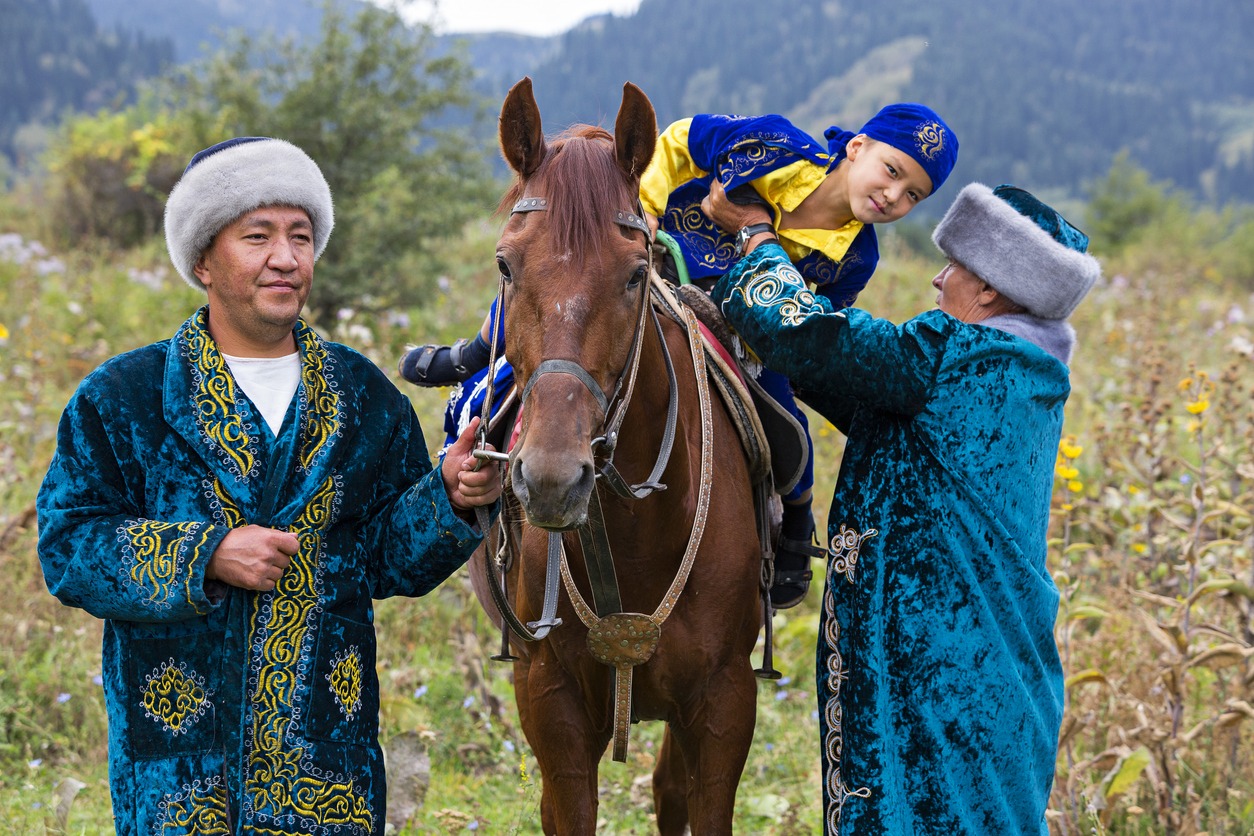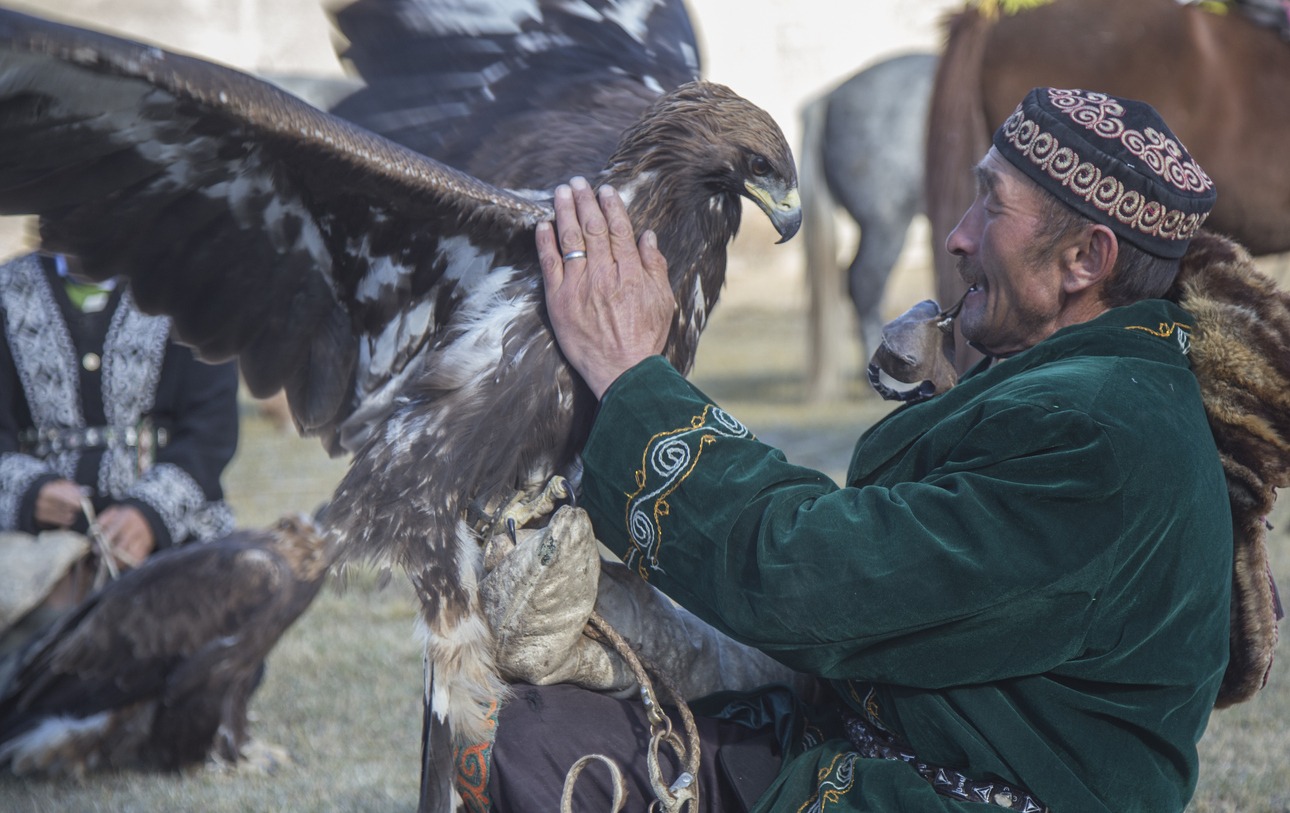Kazakhstan is a country in Central Asia known for its large open spaces and beautiful mountains. This place has a rich history and a mix of different cultural influences from the East and West. One important part of this culture is the Kazakh Shapan, a traditional long coat that is more than just clothing. It represents the history and identity of the Kazakh people.
The Shapan is special because of its unique style and detailed designs. It’s not only practical for the weather in Central Asia, but it also looks good and is important for Kazakh culture. This coat has been around for a long time, changing a bit over the years but still keeping its main qualities.
In this article, we’re going to talk about what makes the Kazakh Shapan so special. We’ll look at its history, how it’s made, and why it’s still important in Kazakhstan today. We’ll see why this coat is not just a piece of clothing but a symbol of Kazakh culture. Let’s learn more about the Shapan and its role in representing a nation’s heritage.
Historical Background of the Shapan
The Kazakh Shapan has a history that dates back several centuries. Originally, it was designed as a practical garment for the nomadic lifestyle of the Kazakh people. The vast steppes of Kazakhstan presented a challenging environment, with harsh winters and hot summers. The Shapan, made from natural materials like wool and felt, provided essential protection against these extreme weather conditions. Its long, flowing design allowed for easy movement on horseback, which was crucial for the nomadic Kazakhs.
Evolution Over Time
Over the years, the Shapan evolved from a purely functional item to a symbol of social status and identity. The design and quality of the Shapan began to vary, reflecting the wearer’s position in society. Wealthier individuals would wear Shapans made from finer materials with elaborate decorations, while simpler designs were worn by the common people. This differentiation made the Shapan a symbol of personal wealth and status within the community.
Cultural Significance and Ceremonial Use
Beyond its practical and social roles, the Shapan also held a ceremonial significance in Kazakh culture. It was commonly worn during important events such as weddings, festivals, and other community gatherings. The Shapan’s role in these events was not just about style or social status; it was a part of the ritual, often passed down from generation to generation as a cherished heirloom. These garments would often be adorned with symbols and patterns that held cultural and historical meanings, connecting the wearer to their ancestors and heritage.
Influence of Historical Events
The history of the Shapan is also intertwined with significant historical events in the region. During periods of political and social change, such as the Russian influence and the Soviet era, the Shapan underwent transformations. These periods saw the introduction of new materials and styles, as well as a blending of cultural influences. However, despite these changes, the Shapan maintained its core identity as a symbol of Kazakh culture.
The Shapan’s historical journey is a reflection of the Kazakh people’s adaptation to their environment, social structure, and historical changes. Its enduring presence in Kazakh culture is a testament to its significance, versatility, and the deep-rooted traditions of the people who created and continue to cherish it.
The Design and Craftsmanship of the Shapan
The Kazakh Shapan is not only a cultural icon but also a masterpiece of design and craftsmanship. Each aspect of its construction, from the choice of fabric to the intricate patterns, is a testament to the skill and artistic expression of Kazakh artisans. The craftsmanship of the Shapan reflects a deep understanding of the materials and a commitment to preserving traditional techniques.
Key Elements of Shapan Design
- Materials Used: Traditionally, the Shapan is made from natural materials such as wool, cotton, and sometimes silk. The choice of material often depends on the climate and the intended use of the garment. Wool is preferred for its warmth and durability, making it ideal for colder climates.
- Color Palette: The colors used in a Shapan can range from vibrant hues to more subdued tones. Historically, the colors were derived from natural dyes, which added a unique character to each garment. The choice of color often has cultural significance, with certain hues representing different aspects of Kazakh life and beliefs.
- Patterns and Symbols: The Shapan is renowned for its decorative patterns and symbols. These can include geometric shapes, floral designs, and motifs inspired by nature. Each pattern is not just decorative but often carries symbolic meanings, telling stories or conveying wishes for good health, prosperity, or protection.
Artisan Techniques
- Hand Sewing and Embroidery: Much of the Shapan’s beauty comes from the intricate hand sewing and embroidery work. This labor-intensive process involves detailed stitching that enhances the garment’s aesthetics and showcases the artisan’s skill.
- Application of Decorative Elements: In addition to embroidery, other decorative elements like beads, sequins, and metal threads can be added to create a more luxurious appearance. These embellishments are often used in Shapans worn for special occasions.
Regional Variations
Each region in Kazakhstan has its unique style and design elements that are reflected in their Shapans. These variations can be seen in the cut of the garment, the type of embroidery used, and the overall style. This diversity illustrates the rich cultural tapestry within Kazakhstan.
Preservation of Traditional Methods
Despite modern advancements, many artisans continue to use traditional methods in creating Shapans. This commitment to tradition not only preserves the historical authenticity of the garment but also keeps alive the skills and knowledge passed down through generations.
The design and craftsmanship of the Kazakh Shapan are a clear reflection of the country’s rich artistic heritage. Each garment is not just a piece of clothing but a work of art, embodying the spirit, history, and skill of the Kazakh people. Through the Shapan, we see a vivid portrayal of a culture that values beauty, tradition, and craftsmanship.
The Shapan in Modern Kazakh Culture
In today’s Kazakhstan, the Shapan continues to hold a significa`nt place, bridging the gap between the traditional past and the modern present. While it retains its cultural and historical roots, the Shapan has adapted to the changing lifestyles and fashion sensibilities of contemporary Kazakhs.
Usage in Modern Times
- Cultural Events and Celebrations: The Shapan remains a popular choice for wear during important cultural events and national celebrations. It is often seen at weddings, religious ceremonies, and national festivals, symbolizing a connection to Kazakh heritage.
- Official and Diplomatic Occasions: Kazakh leaders and diplomats sometimes wear the Shapan at official events, both domestically and internationally, as a representation of national identity and pride.
- Everyday Wear: While not as commonly used in everyday life due to modern clothing preferences, some people still choose to wear simplified versions of the Shapan, especially in rural areas or during special family gatherings.
Influence on Contemporary Fashion
The aesthetic elements of the Shapan have influenced modern Kazakh fashion designers. Elements like traditional patterns and cuts are often incorporated into contemporary clothing designs, creating a blend of old and new. Young designers are reinterpreting the Shapan in modern contexts, making it more wearable for daily life while preserving its cultural essence.
Promoting Cultural Identity Among Youth
Educational initiatives and cultural programs often showcase the Shapan to foster a sense of cultural identity among young Kazakhs. Workshops, exhibitions, and fashion shows featuring the Shapan help keep the tradition alive and relevant for the younger generation.
The Role of Media and Entertainment
The Shapan has also found its place in Kazakh media and entertainment. It is featured in films, television shows, and music videos, often used to depict Kazakh history or celebrate traditional values.
Challenges and Opportunities
While the Shapan faces challenges in maintaining its relevance in a rapidly modernizing society, these challenges also present opportunities. By adapting to contemporary needs and tastes, the Shapan can continue to be a vital part of Kazakh culture.
The Shapan’s journey into modern Kazakh culture illustrates a dynamic balance between preserving traditional heritage and embracing modernity. As a living symbol of Kazakh identity, it continues to evolve, reflecting the nation’s past while participating actively in its present and future cultural landscape.
The Shapan’s Cultural Significance
The Shapan is more than just a traditional garment; it is a potent symbol of Kazakh cultural identity. Its unique design and historical roots deeply resonate with the Kazakh people, serving as a reminder of their rich heritage and distinct cultural identity. In a world where globalization is blurring cultural lines, the Shapan stands as a proud declaration of the Kazakh way of life and values.
Significance in Cultural Preservation
The Shapan acts as a tangible link to Kazakhstan’s history, connecting the present generation with their ancestors. It’s a living piece of history that tells stories of the past and keeps the memory of traditional Kazakh life alive. Wearing the Shapan in ceremonies and festivals is a way to honor and uphold age-old customs and traditions. It helps in preserving practices that might otherwise be lost in the modern era.
Symbol of Unity and Diversity
Across the diverse ethnic landscape of Kazakhstan, the Shapan serves as a unifying symbol. While styles and designs may vary among different regions, the underlying concept of the Shapan remains a common thread that binds the Kazakh people together. The various regional interpretations of the Shapan also showcase the diversity within Kazakh culture. Each regional style tells its own story and adds to the rich cultural mosaic of Kazakhstan.
Influence Beyond Fashion
The Shapan has become an ambassador of Kazakh culture on the global stage. When worn at international events or featured in cultural exchanges, it introduces and educates the world about Kazakh traditions.
Inspiration for Art and Literature: Beyond its role in fashion, the Shapan inspires artists, writers, and musicians, who often use it as a motif to explore and express Kazakh cultural themes.
Educational Role
For the younger generations, the Shapan is a tool for teaching about cultural heritage and values. It provides a tangible means to connect with and understand their cultural roots. The Shapan also highlights the importance of craftsmanship and the value of hand-made, artisanal goods. This promotes appreciation for the skills and dedication involved in traditional craftsmanship.
In essence, the Shapan’s cultural significance in Kazakhstan transcends its physical form. It acts as a custodian of history, a symbol of unity and diversity, and a medium through which Kazakh culture is celebrated, preserved, and promoted. It’s not just a garment; it’s a key to understanding the soul of Kazakh culture.
Challenges and Preservation Efforts
The journey of the Kazakh Shapan through time hasn’t been without its challenges. As the world moves towards an era of fast fashion and globalized styles, traditional garments like the Shapan face the threat of being overshadowed. The younger generation’s inclination towards contemporary fashion trends poses a significant challenge to the survival of this traditional attire.
Preservation of Artisan Skills
One of the major challenges is the decline in the number of skilled artisans who possess the knowledge and ability to create authentic Shapans. This craftsmanship requires years of training and practice, which is becoming increasingly rare. To counter this, various cultural organizations and institutions in Kazakhstan are investing in programs to train new artisans. Workshops and apprenticeships are being set up to pass on these valuable skills to younger generations.
Cultural Shifts and Globalization
The influence of global fashion trends and the accessibility of mass-produced clothing have led to a decreased demand for traditional garments like the Shapan. Initiatives are being taken to instill a sense of cultural pride and identity among Kazakhs, especially the youth. This includes incorporating the Shapan in contemporary fashion, making it more relevant and appealing to younger audiences.
Economic and Market Challenges
Producing a traditional Shapan is often more costly due to the intricate handwork and quality materials required. This can make Shapans less accessible to a broader audience. Strategies are being developed to create economic incentives for producing and wearing the Shapan. This includes supporting local artisans through fair trade practices and promoting the Shapan in both domestic and international markets.
Engagement in Cultural Tourism
Utilizing cultural tourism to showcase the Shapan is another effective preservation strategy. By presenting the Shapan as a key element of Kazakh culture to tourists, there is a dual benefit of cultural exchange and economic support for local artisans.
Digital and Media Involvement
Social media and online platforms are being used to raise awareness about Shapan’s cultural significance. Digital campaigns, online exhibitions, and e-commerce sites are making Shapan more accessible and known to a global audience.
While the challenges to preserving the Kazakh Shapan are significant, the efforts being made to overcome them are robust and multifaceted. Through a combination of training new artisans, cultural pride initiatives, economic strategies, tourism, and digital outreach, there is a concerted effort to ensure that this emblematic garment continues to be an integral part of Kazakhstan’s cultural heritage.
Conclusion
In conclusion, the Kazakh Shapan is not just traditional clothing but an essential part of Kazakhstan’s culture and history. Despite facing modern challenges, efforts are being made to keep this unique tradition alive. Through the dedication of artisans, cultural organizations, and the Kazakh community, the Shapan continues to be a symbol of national pride and heritage. As we look towards the future, it’s clear that the Shapan will remain an important and cherished part of Kazakh culture, connecting the past with the present and future.



